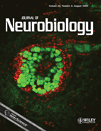Annual cycle of the black-capped chickadee: Seasonality of singing rates and vocal-control brain regions
Abstract
Black-capped chickadees have a rich vocal repertoire including learned calls and the learned fee-bee song. However, the neural regions underlying these vocalizations, such as HVC, area X, and RA (robust nucleus of arcopallium), remain understudied. Here, we document seasonal changes in fee-bee song production and show a marked peak in singing rate during March through May. Despite this, we found only minimal seasonal plasticity in vocal control regions of the brain in males. There was no significant effect of time of year on the size of HVC, X, or RA in birds collected in January, April, July, and October. We then pooled birds into two groups, those with large testes (breeding condition) and those with small testes (nonbreeding), regardless of time of year. Breeding birds had slightly larger RA, but not HVC or X, than nonbreeding birds. Breeding birds had slightly larger HVC and RA, but not X, as a proportion of telencephalon volume than did nonbreeding birds. Birds collected in July had heavier brains than birds at other times of year, and had the greatest loss in brain mass during cryoprotection. The absence of any overall seasonal change in the vocal-control regions of chickadees likely results from a combination of individual differences in the timing of breeding phenology and demands on the vocal-control regions to produce learned calls year-round. © 2006 Wiley Periodicals, Inc. J Neurobiol, 2006




